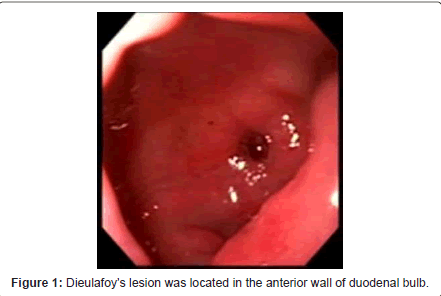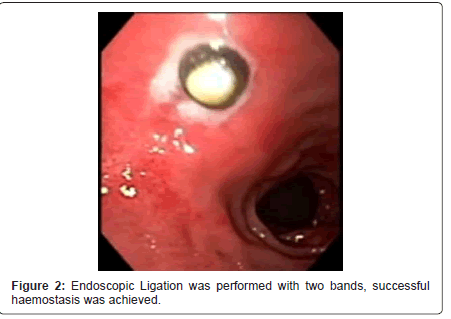Case Report Open Access
Successful Endoscopic Band Ligation of Duodenal Dieulafoy's Lesion
Edson Guzmán1,3*, Pedro Montes2, Miguel Espinoza2 and Eduardo Monge2,41Gastroenterology Unit of Hospital Nacional Edgardo Rebagliati Martins, Peru
2Gastroenterology Unit of Hospital Daniel Alcides Carrion, Callao, Peru
3Universidad Peruana de Ciencias Aplicadas (UPC), Peru
4Universidad Peruana Cayetano Heredia, Peru
- *Corresponding Author:
- Gerly Edson Guzmán Calderon
Prol. Manco II 115 - Condominio VIlla Marina
Club-Torre A Dpto 1101 San Miguel
Lima, Peru
E-mail: edson_guzman@hotmail.com
Received date: July 24, 2012; Accepted date: August 07, 2012; Published date: August 09, 2012
Citation: Guzmán E, Montes P, Espinoza M, Monge E (2012) Successful Endoscopic Band Ligation of Duodenal Dieulafoy’s Lesion. J Gastroint Dig Syst 2:117. doi: 10.4172/2161-069X.1000117
Copyright: © 2012 Guzmán E, et al. This is an open-access article distributed under the terms of the Creative Commons Attribution License, which permits unrestricted use, distribution, and reproduction in any medium, provided the original author and source are credited.
Visit for more related articles at Journal of Gastrointestinal & Digestive System
Abstract
Dieulafoy’s lesion (DL) is an abnormal arterial lesion in the digestive tract. We report a 21-year-old male, without any relevant his past medical and familiar history. He admitted to the ER with a history of hematemesis and melena. An upper endoscopy showed a protruding vessel without surrounding venous dilatation, active bleeding or mucosal defect. This vascular lesion was located in the anterior wall of duodenal bulb. Endoscopic ligation subsequently performed with two bands and a successful haemostasis achieved.
Case Report
Dieulafoy’s lesion (DL) is an abnormal arterial lesion in the digestive tract [1]. These lesions account for up to 5% of acute upper gastrointestinal haemorrhages [2]. The stomach is the most frequently comprised, around 75% of all cases. The classic site is the proximal lesser curvature within 6 cm of the gastroesophageal junction and accounts for approximately 65% of the gastric lesions. The duodenum is the second most common site for DL and over half of the DL encountered in the duodenum occurs in the bulb [3].
We report a 21-year-old male, without any relevant his past medical and familiar history. He admitted to the ER with a three hours history of hematemesis and melena. His physical examination showed a, heart rate of 89 bpm, blood pressure 110/60, no orthostatism, abdominal examination showed a non-distended abdomen with slight epigastric pain, and no organomegaly. The cardiovascular, respiratory and neurological examinations were unchanged.
The laboratory results showed: Hemoglobin: 11.1 gr/dl, WBC count: 8900 cells/mm3, platelets count: 235,000, LFTs: normal. Abdominal US and a plain abdominal X-ray were also normal. An upper endoscopy showed a protruding vessel without surrounding venous dilatation, active bleeding or mucosal defect. This vascular lesion was located in the anterior wall of duodenal bulb (Figure 1).
Endoscopic injection using 1:10,000 epinephrine solution was performed in four quadrants (2.5 ml in each quadrant), initially had not bleeding. The following day one proceeded to a review of the injected zone, observing active bleeding for which immediately it performed a mechanical therapy. Endoscopic ligation was subsequently performed with two bands and a successful haemostasis was achieved (Figure 2). Two weeks later, it was possible to evaluate the aspect of the duodenal bulb with a suitable improvement.
Conclusion
The Dieulafoy’s lesion is an uncommon, but potentially severe cause of gastrointestinal bleeding. It may found in any location within the gastrointestinal tract but is more frequent in the stomach; nevertheless, other regions have been considerate. Endoscopic therapy is effective and safe. Injected epinephrine alone is associated with a higher risk of rebleeding [4]. Whereas mechanical therapy is more effective with a recurrence of bleeding was significantly lower with banding or clipping (8.3%) than with injection method (33%) [5].
Acknowledgements
Salazar Sonia MD, Ramos Milko MD, Huamán Cesar MD, Cárdenas Irene MD, Monge Eduardo MD. Physicians of the Gastroenterology Unit of the Hospital Daniel A. Carrión, Callao, Peru.
References
- Ding YJ, Zhao L, Liu J, Luo HS (2010) Clinical and endoscopic analysis of gastric Dieulafoy’s lesion. World J Gastroenterol 16: 631-635.
- Hurlstone DP (2002) Successful Endoscopic Band Ligation of Duodenal Dieulafoy’s Lesions. Further Large Controlled Studies Are Required. Scand J Gastroenterol 37: 620.
- Yuk Tong L, Russell SW, Rupert WL, Joseph JS (2003) Dieulafoy's lesion. Gastroint Endosc 58: 236-243.
- Ibañez A, Castro E, Fernández E, Baltar R, Vázquez S, et al. (2007) Clinical aspects and endoscopic management of gastrointestinal bleeding from Dieulafoy’s lesion. Rev Esp Enferm Dig 99: 505-510.
- Regula J, Wronska E, Pachlewski J (2008) Vascular lesions of the gastrointestinal tract. Best Pract Res Clin Gastroenterol 22: 313-328.
Relevant Topics
- Constipation
- Digestive Enzymes
- Endoscopy
- Epigastric Pain
- Gall Bladder
- Gastric Cancer
- Gastrointestinal Bleeding
- Gastrointestinal Hormones
- Gastrointestinal Infections
- Gastrointestinal Inflammation
- Gastrointestinal Pathology
- Gastrointestinal Pharmacology
- Gastrointestinal Radiology
- Gastrointestinal Surgery
- Gastrointestinal Tuberculosis
- GIST Sarcoma
- Intestinal Blockage
- Pancreas
- Salivary Glands
- Stomach Bloating
- Stomach Cramps
- Stomach Disorders
- Stomach Ulcer
Recommended Journals
Article Tools
Article Usage
- Total views: 14906
- [From(publication date):
December-2012 - Oct 29, 2025] - Breakdown by view type
- HTML page views : 10227
- PDF downloads : 4679


